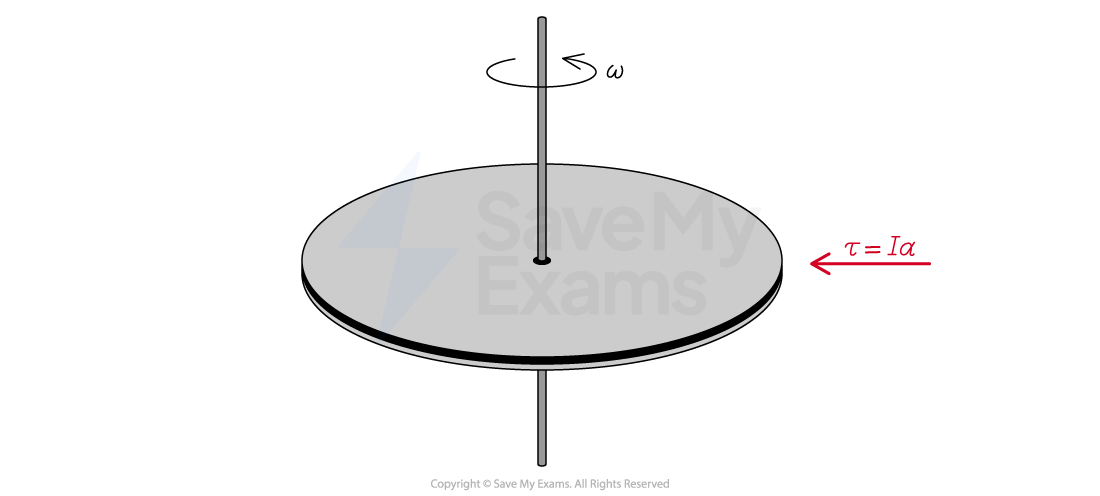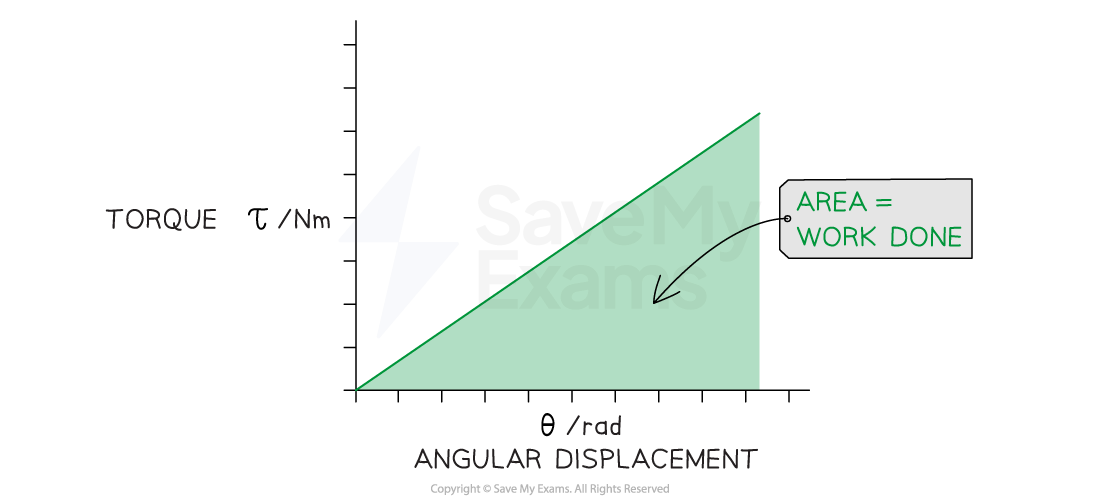Torque & Work (College Board AP® Physics 1: Algebra-Based): Study Guide
Work done by torque
When a torque is exerted over an angular displacement, energy is transferred into or out of an object or rigid system
Some examples of this include rotating cranes and fairground rides
The work done on a rigid system by a torque is given by:
Where:
= work done, in
= torque, in
= angular displacement, in
Equivalent amounts of work can be done on a rigid system by
exerting a smaller torque over a greater angle of rotation
exerting a larger torque over a smaller angle of rotation
This is analogous to systems with linear acceleration, where work done is the product of the force and the linear displacement
Comparing work done on translational and rotational systems

Worked Example
A horizontally mounted wheel with rotational inertia spins about a frictionless axle. At time t = 0, the angular speed of the wheel is
. A constant torque
is applied to the wheel which causes it to come to rest in time
.
Derive an expression for the average power required to dissipate the wheel's energy in terms of ,
and
.
Answer:
Step 1: Analyze the scenario
Initially, the wheel spins with an initial angular speed of
After time
, the wheel has a final angular speed of
The torque
applied to the wheel is constant, therefore the angular acceleration
is also constant
Hence, we can use the rotational form of Newton's second law as well as the equations of constant angular acceleration in our derivation

Step 2: Write an expression for the average power supplied to the wheel
The work done on the wheel is:
The torque applied to the wheel is:
Therefore, the average power supplied to the wheel is:
Step 3: Write an expression for the angular acceleration of the wheel
The rotational kinematic equation relating
,
,
and
is:
Where
and
:
Step 4: Write an expression for the angular displacement of the wheel
The rotational kinematic equation relating
,
,
and
is:
Where
and
:
Step 5: Combine the equations and simplify
Substituting these equations into the expression for power:
Torque-angular position graph
A changing torque can be plotted as a function of angular displacement
The work done on a rigid system is equal to the product of torque and angular displacement
Therefore, the area under the torque-angular position graph is equal to
work done
change in kinetic energy
Determining work done from a torque-angular displacement graph

The graph may show positive or negative values of torque
Positive areas represent positive work i.e. energy added to the system
Negative areas represent negative work i.e. energy removed from the system
This is analogous to linear work done being equal to the area under a force-displacement graph
Worked Example
A cylinder of mass 5.0 kg and radius 0.20 m is mounted on an axle parallel to its axis and through its center of mass. The rotational inertia of the cylinder about this axis is . The cylinder is initially at rest before a force is applied to a point on its edge which causes it to rotate. The graph shows the net torque exerted on the cylinder as a function of angular position.

Determine the angular velocity of the cylinder after it completes one full revolution.
Answer:
Step 1: Analyze the scenario
One full revolution is equivalent to 2π rad
A constant positive torque of 10 N·m is applied until the cylinder rotates through π rad
At
= π rad, the direction of the applied torque changes
A constant negative torque of −5 N·m is then applied as the cylinder rotates through another π rad
Overall, the work done on the cylinder:
is positive from
= 0 to
= π, so the angular velocity will increase
is negative from
= π to
= 2π, so the angular velocity will decrease
Step 2: Determine the work done over the 2π rotation
The area under a torque-angular position graph is equal to the work done, or the change in kinetic energy

Area under the positive section =
Area under the negative section =
Therefore, the work done, or net change in kinetic energy is:
Step 3: Determine the final angular velocity of the cylinder
The change in kinetic energy is equal to
Where
= 5.0 kg and
= 0.20 m (and
= 0)
Therefore, after a full revolution
, the cylinder's angular velocity is:

Unlock more, it's free!
Did this page help you?